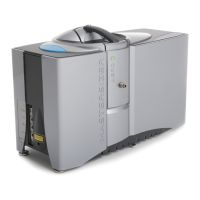Hardware features
44
The technique to fill the cuvette used with the Hydro SV is the same as for any cuvette;
make sure that the dispersant is carefully injected into the cuvette with the minimum of
bubbles produced.
The cuvette is filled and inserted into the SV cell while the cell is out of the optical unit.
Note: Try not to use dispersants with too high a viscosity. The greater the vis-
cosity of the dispersant, the less effective the stirrer bar sample dispersion will
be.
Note: Any aqueous dispersant must be degassed fully before use. For aqueous
use only correctly degassed deionized water (negligible dissolved C0
2
), or sig-
nificant bubbles will form on the windows and stirrer and will affect the quality
of the measurement.
Filling the syringe
l If using an aqueous dispersant, a plastic syringe is sufficient.
l A glass syringe may be required for any non-aqueous dispersants.
l Fit the syringe tip onto the end of the syringe.
l Place the syringe tip into the dispersant, then pull the plunger back to draw the
dispersant into the syringe - to a minimum of 6 ml.
Note: The maximum volume of the cuvette is 7 ml. This corresponds to a min-
imum volume of 6 ml dispersant + 1 ml maximum of sample. If more than 7 ml
of sample/dispersant is inserted the cuvette will overflow.

